Themed collection Editors' collection: Carbon Dioxide Capture/Reduction

Catalysis with carbon nanoparticles
Carbon nanoparticles represent a new class of nanocatalysts able to catalyze different reactions. This review collects the catalytic applications of these nanoparticles.

RSC Adv., 2019,9, 27659-27664
https://doi.org/10.1039/C9RA05689K
A review of plasma-assisted catalytic conversion of gaseous carbon dioxide and methane into value-added platform chemicals and fuels
The review focuses on the valorisation of two major greenhouse gases (methane and carbon dioxide) utilising different hybrid plasma reactors where valuable chemicals such as higher hydrocarbons, alcohols, aldehydes, carboxylic acids, etc. are produced.

RSC Adv., 2018,8, 27481-27508
https://doi.org/10.1039/C8RA03146K
A short review of recent advances in CO2 hydrogenation to hydrocarbons over heterogeneous catalysts
CO2 hydrogenation to hydrocarbons over heterogeneous catalysts.

RSC Adv., 2018,8, 7651-7669
https://doi.org/10.1039/C7RA13546G
Facile one-pot synthesis of Mg-doped g-C3N4 for photocatalytic reduction of CO2
Graphitic carbon nitride (g-C3N4) has attracted wide attention due to its potential in solving energy and environmental issues.

RSC Adv., 2019,9, 28894-28901
https://doi.org/10.1039/C9RA04606B
Natural rubber latex foam with particulate fillers for carbon dioxide adsorption and regeneration
To reduce the carbon dioxide (CO2) concentration in the atmosphere, natural rubber (NR) was developed as a rubber foam for CO2 adsorption.
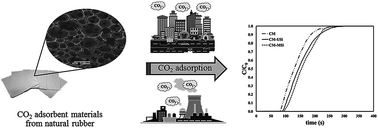
RSC Adv., 2019,9, 28916-28923
https://doi.org/10.1039/C9RA06000F
Novel bovine carbonic anhydrase encapsulated in a metal–organic framework: a new platform for biomimetic sequestration of CO2
A novel heterogeneous bio-catalyst was developed for CO2 capture by encapsulating bovine carbonic anhydrase into ZIF-8.

RSC Adv., 2019,9, 28460-28469
https://doi.org/10.1039/C9RA04603H
Efficient electrocatalytic reduction of carbon dioxide by metal-doped β12-borophene monolayers
These new TM–Bβ12 monolayers will display excellent catalytic performance for electroreduction of CO2. Primary reduction product of Sc is CO (overpotential 0.45 V). Primary product Ti–Zn is CH4, and Fe–Bβ12 has 0.45 V overpotential.
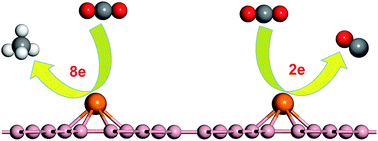
RSC Adv., 2019,9, 27710-27719
https://doi.org/10.1039/C9RA04135D
Controlling the nucleophilic properties of cobalt salen complexes for carbon dioxide capture
The nucleophilic properties of cobalt salen complexes are examined using density functional theory to investigate its carbon fixing capacity.
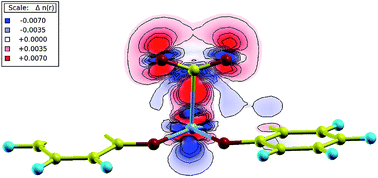
RSC Adv., 2019,9, 23254-23260
https://doi.org/10.1039/C9RA01990A
Enhanced photocatalytic reduction of CO2 to CO over BiOBr assisted by phenolic resin-based activated carbon spheres
Photocatalytic reduction of CO2 using solar energy to decrease CO2 emission is a promising clean renewable fuel production technology.

RSC Adv., 2019,9, 14391-14399
https://doi.org/10.1039/C9RA01329F
Solar driven reduction of CO2 using Pt–Cu/C as a catalyst in a photoelectrochemical cell: experiment and mechanism study
Carbon supported nano-metal catalysts are expected to improve CO2 reduction selectivity and efficiency due to the addition of more active sites and enhancement of electron transport ability.
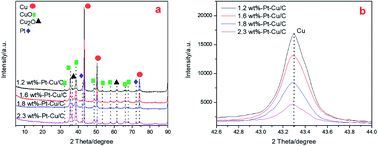
RSC Adv., 2019,9, 10635-10644
https://doi.org/10.1039/C9RA00176J
Enhanced catalytic activity of Au core Pd shell Pt cluster trimetallic nanorods for CO2 reduction
Au@Pd@Pt nanorods greatly enhance the catalytic activities for CO2 reduction because of Pd–Pt edge active sites as investigated by SERS.
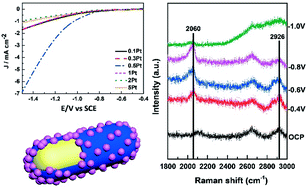
RSC Adv., 2019,9, 10168-10173
https://doi.org/10.1039/C8RA10494H
Optimum operating parameters of CO2 sorption in turbulent fluidized bed regime using potassium carbonate supported on gamma alumina solid sorbent
The promising solid sorbent, potassium carbonate (K2CO3) supported on gamma alumina (γ-Al2O3) prepared through impregnation was inserted into the sorption turbulent riser to determine the optimum operating parameters.
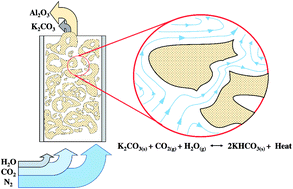
RSC Adv., 2018,8, 39678-39690
https://doi.org/10.1039/C8RA08335E
Synthesis and photocatalytic CO2 reduction performance of aminated coal-based carbon nanoparticles
Aminated coal-based carbon nanoparticles (NH2-CNPs) was fabricated. The physical properties and chemical structure of the NH2-CNPs was studied. Photocatalytic CO2 reduction activity of NH2-CNPs were measured and the reaction mechanism was discussed.

RSC Adv., 2018,8, 35989-35997
https://doi.org/10.1039/C8RA06062B
Preparation of a Cu(BTC)-rGO catalyst loaded on a Pt deposited Cu foam cathode to reduce CO2 in a photoelectrochemical cell
Schematic of a photoelectrochemical cell for CO2 reduction: the H+ generation process and the CO2 process run in two separated chambers respectively.

RSC Adv., 2018,8, 32296-32303
https://doi.org/10.1039/C8RA05964K
Synthesis of heterometallic metal–organic frameworks and their performance as electrocatalyst for CO2 reduction
The solventless synthesis of heterometallic metal–organic frameworks and their proficient behavior as electrocatalysts in the CO2 reduction to alcohols is presented.
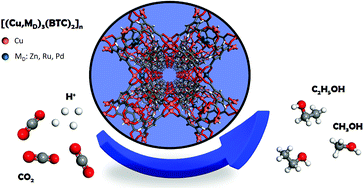
RSC Adv., 2018,8, 21092-21099
https://doi.org/10.1039/C8RA02676A
Improving the photocatalytic reduction of CO2 to CO for TiO2 hollow spheres through hybridization with a cobalt complex
A chemical system with enhanced efficiency for electron generation and transfer was constructed by the integration of TiO2 hollow spheres with [Co(bipy)3]2+.
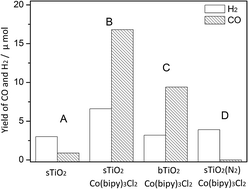
RSC Adv., 2018,8, 20543-20548
https://doi.org/10.1039/C8RA03211D
TiO2 surfaces self-doped with Ag nanoparticles exhibit efficient CO2 photoreduction under visible light
It is a simple process of realizing Ag nanoparticles deposition and TiO2 self-doping, which can promote the photocatalytic performance.

RSC Adv., 2018,8, 15991-15998
https://doi.org/10.1039/C8RA02362J
High-efficiency photocatalytic CO2 reduction in organic–aqueous system: a new insight into the role of water
A high efficiency photocatalytic conversion of CO2 into CO has been achieved by construction of a binary liquid system.

RSC Adv., 2018,8, 3798-3802
https://doi.org/10.1039/C7RA12801K
About this collection
This collection is edited by Associate Editor Professor Carlos D. Garcia (Clemson University) and contains selected Reviews, Communications and full Papers published since 2018. The collection features the most remarkable contributions published in the journal and aims to highlight recent work published and raise awareness of the most current strategies to mitigate the impact of CO2 on the atmosphere.
These articles describe strategies to either promote the capture of CO2 or its reduction to yield organic compounds of higher value (methane, methanol, carbon monoxide, and short-chain organic acids). Although most of these articles describe clever chemical reactivity, their main focus ranges from biomimetic approaches to electrochemistry and photocatalysis.